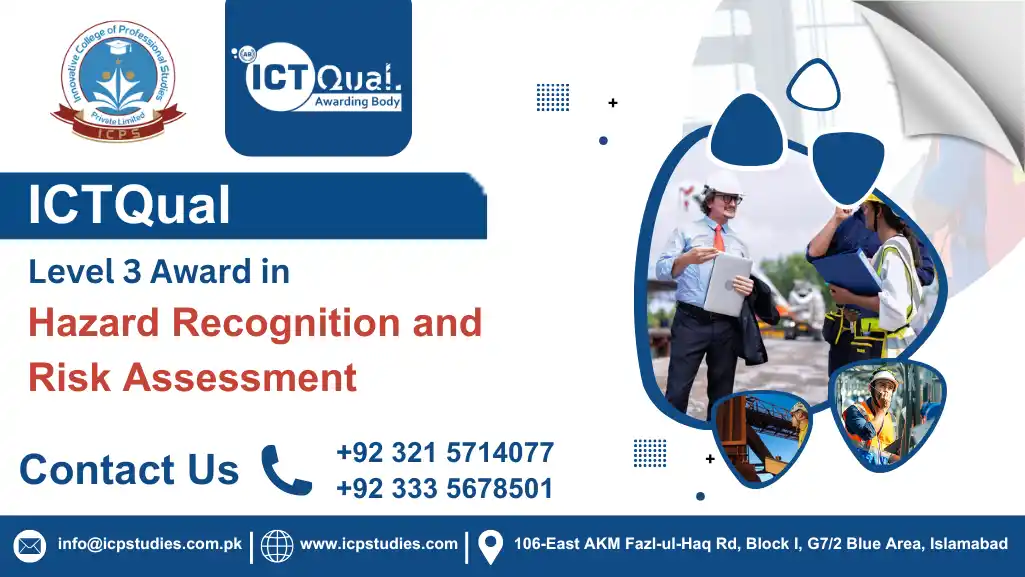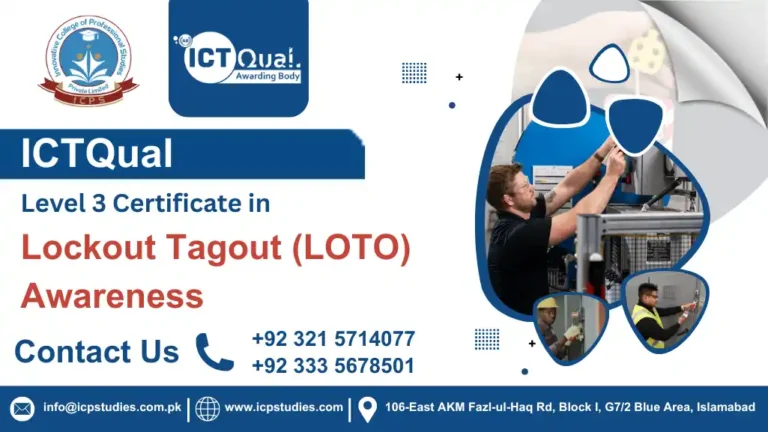In today’s fast-paced work environments, ensuring a safe and healthy workplace is not just a legal obligation but also a moral responsibility. Hazard recognition and risk assessment are crucial in mitigating potential dangers that could harm employees, contractors, or visitors. One of the most effective ways to equip yourself or your team with the skills needed to identify and manage risks is through the ICTQual Level 3 Award in Hazard Recognition and Risk Assessment.
The ICTQual Level 3 Award in Hazard Recognition and Risk Assessment is a nationally recognised qualification aimed at individuals who are involved in health and safety management or have responsibilities related to workplace safety. The award focuses on key principles in hazard identification, risk assessment, and implementing risk control measures to protect workers from harm. It is an ideal qualification for supervisors, managers, safety officers, and anyone tasked with maintaining a safe work environment.
The ICTQual Level 3 Award in Hazard Recognition and Risk Assessment is a highly valuable qualification for anyone involved in health and safety or risk management. By completing this course, you will not only enhance your understanding of hazard identification and risk assessment but also gain the practical skills needed to improve workplace safety.
All About ICTQual Level 3 Award in Hazard Recognition and Risk Assessment
Course Overview
The ICTQual Level 3 Award in Hazard Recognition and Risk Assessment is a comprehensive qualification designed to equip individuals with the essential knowledge and practical skills needed to identify, assess, and manage risks in the workplace. This accredited course focuses on developing the expertise required to recognise hazards, carry out thorough risk assessments, and implement effective control measures to ensure a safer working environment. Whether you are new to health and safety or looking to advance your skills, this course provides a solid foundation in risk management principles.
Throughout the course, participants will explore key topics such as the various types of workplace hazards, the process of conducting structured risk assessments, and the hierarchy of risk control measures. Additionally, the programme covers essential safety regulations, ensuring compliance with UK health and safety laws. The course is suitable for safety officers, managers, and anyone responsible for ensuring workplace safety, making it applicable across a wide range of industries including construction, healthcare, manufacturing, and more.
Study Units
- Principles of Hazard Recognition and Risk Analysis
- Advanced Risk Assessment Techniques
- Legal and Regulatory Aspects of Risk Management
- Implementation of Risk Control Measures
- Workplace Safety Culture and Risk Communication
- Evaluating and Improving Risk Management Practices
- Emergency Response and Incident Management
Minimum Age: Participants must be at least 18 years of age to enrol in the course.
Educational Background: There are no specific formal educational qualifications required for entry into this course. However, a basic understanding of workplace practices and safety will be beneficial. Those with a background in management, health and safety, or risk management will find the course content easier to grasp, but it is open to all interested learners.
Work Experience: While prior work experience is not mandatory, some familiarity with workplace environments, especially in industries that involve health and safety protocols (such as construction, manufacturing, or healthcare), will enhance the learning experience. Practical exposure to workplace safety practices is helpful, though not required.
Language Proficiency: As the course materials and assessments are conducted in English, a good understanding of written and spoken English is necessary. Participants should be able to read, write, and communicate effectively in English to fully engage with the course content and complete assignments and assessments.
Anyone Seeking to Comply with Health and Safety Regulations: Employees or managers looking to ensure workplace compliance with UK health and safety laws and improve organisational safety standards.
Health and Safety Professionals: Ideal for safety officers, managers, and supervisors who are responsible for overseeing and ensuring the safety of the workforce.
Team Leaders and Supervisors: Those in leadership roles who manage teams and need to understand hazard recognition and risk assessment to maintain workplace safety.
Employees Looking to Advance in Health and Safety: Individuals looking to expand their knowledge and skills in risk management to pursue a career in health and safety.
Industry Workers in High-Risk Environments: Professionals working in sectors such as construction, manufacturing, healthcare, and warehousing where hazard identification and risk management are crucial.
Those New to Risk Management: Suitable for individuals who are new to health and safety and want to develop a foundational understanding of workplace hazard identification and risk assessment.
Learning Outcomes
Principles of Hazard Recognition and Risk Analysis
- Understand the core principles of hazard recognition and risk analysis.
- Identify different types of hazards and risks in various workplace environments.
- Learn to assess the potential impact of identified hazards on health and safety.
- Apply basic risk analysis methods to evaluate the severity and likelihood of risks.
Advanced Risk Assessment Techniques
- Gain knowledge of advanced risk assessment methodologies and techniques.
- Learn to use tools like risk matrices, fault tree analysis, and failure mode effects analysis (FMEA).
- Develop skills in assessing complex risks and uncertainties in dynamic work environments.
- Apply advanced techniques to prioritise risks based on severity, likelihood, and potential impact.
Legal and Regulatory Aspects of Risk Management
- Understand the key health and safety laws and regulations that impact risk management.
- Learn the responsibilities of employers, employees, and other stakeholders in risk management.
- Gain knowledge of UK-specific legislation such as the Health and Safety at Work Act and other related regulations.
- Apply legal requirements to ensure compliance with workplace safety standards and reduce legal risks.
Implementation of Risk Control Measures
- Develop practical skills in implementing various risk control measures across different work environments.
- Understand the hierarchy of controls, including elimination, substitution, engineering controls, and administrative controls.
- Learn to assess and monitor the effectiveness of implemented control measures.
- Identify strategies for continuous improvement in risk control and safety performance.
Workplace Safety Culture and Risk Communication
- Understand the importance of cultivating a safety culture within the workplace.
- Develop strategies for promoting safety awareness and behaviour among employees.
- Learn effective communication techniques for discussing risk, safety procedures, and emergency protocols with staff.
- Understand how to engage employees in the risk management process through consultation and feedback.
Evaluating and Improving Risk Management Practices
- Learn methods for evaluating the effectiveness of existing risk management practices.
- Develop skills in identifying gaps and areas for improvement in current risk management systems.
- Apply continuous improvement techniques such as Plan-Do-Check-Act (PDCA) to refine risk management practices.
- Monitor and review risk management performance to ensure long-term safety and compliance.
Emergency Response and Incident Management
- Understand the principles of effective emergency response and incident management.
- Learn to develop, implement, and review emergency plans and procedures.
- Gain skills in coordinating emergency response efforts and managing incidents to minimise damage and risk.
- Understand how to conduct post-incident analysis to prevent future occurrences and improve safety practices.
FAQs ICTQual Level 3 Award in Hazard Recognition and Risk Assessment







